This is a page within the www.staffshomeguard.co.uk website. To see full contents, go to SITE MAP.
MEMORIES
AND INFORMATION - STAFFS HOME GUARD
22nd STAFFORDSHIRE WOLVERHAMPTON) BATTN.
and
Sgt. GEOFFREY HANLEY
|
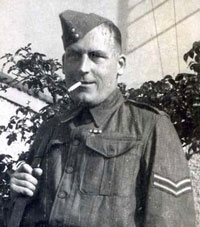 Sergeant Geoffrey Hanley
(1899-1967)
was a member of the 22nd Staffordshire (Wolverhampton)
Battalion. He was a member of
"C" Coy. of this Battalion
(pictured
here). On the surface, his Home Guard life must have
seemed like that of hundreds of thousands of other men:
constant duties of various kinds and training and
exercises in every infantry technique, all occupying many
hours a week, for four and a half years.
Sergeant Geoffrey Hanley
(1899-1967)
was a member of the 22nd Staffordshire (Wolverhampton)
Battalion. He was a member of
"C" Coy. of this Battalion
(pictured
here). On the surface, his Home Guard life must have
seemed like that of hundreds of thousands of other men:
constant duties of various kinds and training and
exercises in every infantry technique, all occupying many
hours a week, for four and a half years.
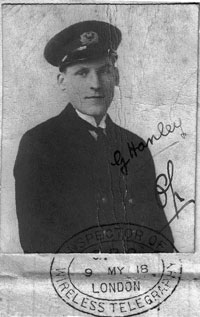 But there was a
bit more to it than that, and the secrets of his service
were not to be revealed for 70 years.
But there was a
bit more to it than that, and the secrets of his service
were not to be revealed for 70 years.
Geoff had
seen Great War service, as his medal ribbon attests. He
had been a naval wireless telegraphist and an image of him
from this time survives
(right). In 1930
he married and became a family man with two children,
Philip and Robert. One of his interests was wireless. In
the garden of his home at 20 Uplands Road,
Wolverhampton, was a garden shed linked by cable to
20 foot high wireless poles elsewhere in the back garden.
This was his "radio shack". Someone who knew him,
Harry Platt, later
described*
how Geoff had encouraged
his own interest in this technology by demonstrating how
it could be used to communicate with other radio hams all
over the world.
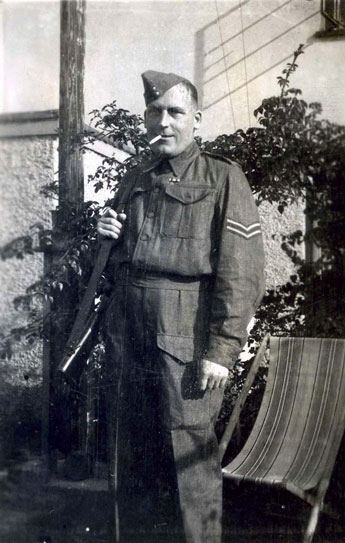
*(in a newspaper article
entitled "Researchers discover Wolverhampton man's secret
past" - Wolverhampton Express & Star, 19th September 2014)
When war broke out Geoff, a sales representative
for Spillers Flour, was an early volunteer
for the Home Guard. His Great War experience would have
singled him out for fairly immediate appointment to a position of
responsibility and a surviving image shows him when
holding the rank of Corporal
(left|). He's in his back garden, the deckchair
has been abandoned, his Lee Enfield is over his shoulder,
a Woodbine or similar dangles from his lips and to his
right there is a large pole. The true significance of the
latter object is going to remain wholly unknown for seven
decades.

Promotion occurs and we next see him, perhaps in 1941/2,
with his Sergeant's stripes, again in the garden and now
sitting with his younger son, Robert and the family's
Staffordshire bull terrier, Buller
(right).
As a Sergeant he is seen
(below) helping to
form a Guard of Honour for the visit to Wolverhampton of
an earlier Prime Minister of Canada, the
Right Honourable Richard Bedford Bennett, 1st Viscount
Bennett. He had been
Canada's 11th Prime Minister between 1930 and 1935 and
later moved to the U.K. Sgt. Geoff Hanley is
standing second from the right in this image
(below) as the
distinguished visitor is welcomed outside
Wolverhampton
Town Hall.
With Viscount Bennett are
Major C.
Hamilton Shaw,
Company Commander, and
Col.
W.J. Beddows, M.C., Group
Commander, No.1 Group, South Staffordshire Zone Home Guard.
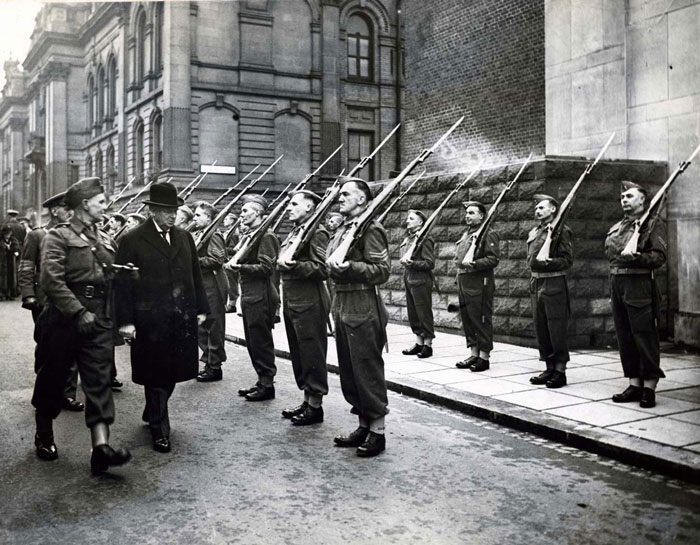
Geoff was part of the
Battalion HQ staff. Below is a 1944 picture of him
and his immediate comrades - who include two women
auxiliary members of the Battalion who almost certainly
provided administrative support.

Click on the above
image to see a magnified version
Geoff is located
9th from
the left in the second main row back. The venue is unknown but
is likely to be the garden at
"Ellerslie", Riley Crescent, Penn,
or in the grounds of
Bantock House.
We can only guess at the occasion but it could well have
been to mark the imminent stand-down which was announced
in October 1944.
The officer
5th from the left in the front (seated) row is
Harry Hill
who was a near neighbour in Uplands Avenue. He also was a
radio ham. Was this more than a coincidence? And did he
share Geoff's secret?
And so, what was Geoff Hanley's secret? His interest
and expertise in wireless telegraphy must have quickly
become known to the authorities and the real significance
of the two massive 60ft poles in his garden between which
his radio aerial was strung - one of which can be seen in
an image above - now becomes apparent. Geoff
was a
"Voluntary Interceptor"
working for the Radio Signals Service (R.S.S.) Here
is a bit of background information.
WHAT
WERE VOLUNTARY INTERCEPTORS AND THE R.S.S?
It was obvious that
the collection of military intelligence through
radio interceptions would be all-important in time
of war. In the summer of 1939 Arthur Platt,
President of the Radio Society of Great Britain,
was asked by the War Office to identify amateur
radio enthusiasts who were prepared to listen out
for clandestine broadcasts using Morse code on
shortwave bands. As a result of this some 1200
"radio hams" became Voluntary Interceptors as part
of the Radio Security Service which by 1941 had
become controlled by MI8(C).
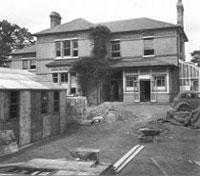 The
RSS operated initially out of some vacated cells
in Wormwood Scrubs Prison with a direct link to
Bletchley Park and later, as the activities grew,
moved to Arkley View, a large house near Barnet.
Its function was to coordinate the interception of
messages by V.I.s and others, to analyse the
results and to decide on appropriate action. It
was staffed by some very intelligent people,
including university professors, and a certain
amount of deciphering was carried out in parallel
with the work being done at Bletchley Park. The
RSS operated initially out of some vacated cells
in Wormwood Scrubs Prison with a direct link to
Bletchley Park and later, as the activities grew,
moved to Arkley View, a large house near Barnet.
Its function was to coordinate the interception of
messages by V.I.s and others, to analyse the
results and to decide on appropriate action. It
was staffed by some very intelligent people,
including university professors, and a certain
amount of deciphering was carried out in parallel
with the work being done at Bletchley Park.
The recruitment of
Voluntary interceptors started early, well before
the establishment of the Home Guard in May 1940.
Many radio hams were being called up into the RAF
Civilian Wireless Reserve, the Territorial Army
Signals Unit and the Royal Navy Volunteer
(Wireless) Reserve. Others either volunteered or
were invited to become V.I.s, usually operating
from their own homes. All amateur radio
transmitters had been impounded at the outbreak of
war but receiving equipment had been retained by
the enthusiasts. Any radio amateur at that time,
in order to obtain a licence, had to demonstrate a
proficiency in Morse code and clearly this made
them especially valuable for the monitoring of
enemy transmissions. Such was the importance of
this activity that it was regarded as a reserved
occupation which was not liable for call up.
Furthermore, provided a minimum monthly
listening-out service level was achieved, the
volunteer would be excused Civil Defence
activities, including normal Home Guard duties. As
a security cover and to protect the operators,
volunteers were sometimes regarded as members of
the Observer Corps and other Civil Defence
services. Home Guard cover may also have been used
in this way.
Voluntary
Interceptors were given procedures whereby
particular call signs or types of signal could be
picked up. Of particular interest were messages
which consisted of groups of five letters which
was the normal method of transmitting secret,
coded information. V.I.s may or may not have been
aware of it, but the initial emphasis of their
operations was to identify
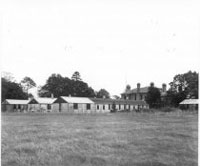 transmissions
emanating from the UK which would obviously
indicate spying and other undercover activities.
It became obvious that no such transmissions were
occurring and so attention became concentrated on
German military and secret service activities. The
V.I.s' equipment was their own receiving apparatus
and they were issued with a reference number,
blank log sheets, postage stamps and envelopes
addressed to "Box 25, Barnet, Herts". The
procedure was to place the completed log inside a
stamped addressed envelope which was then inserted
into another addressed envelope to Box 25. transmissions
emanating from the UK which would obviously
indicate spying and other undercover activities.
It became obvious that no such transmissions were
occurring and so attention became concentrated on
German military and secret service activities. The
V.I.s' equipment was their own receiving apparatus
and they were issued with a reference number,
blank log sheets, postage stamps and envelopes
addressed to "Box 25, Barnet, Herts". The
procedure was to place the completed log inside a
stamped addressed envelope which was then inserted
into another addressed envelope to Box 25.
It seem that this
voluntary activity continued for the entire length
of the war, although the importance of the work
and its volume led to the need for parallel
24-hour monitoring by full-time personnel. For
obvious reasons not a single transmission recorded
by Voluntary Interceptors would have been
intelligible to them and this represents yet
another reason to admire the dedication of their
work over a long period. And they must have been
all too aware that in the event of occupation
their previous activities would hardly have been
well looked upon by the conquering forces. |
The story of Geoff Hanley's involvement in all this did however not
emerge until 2014 when Harry Platt, mentioned above, donated Geoff's
headphones and some other material to the
Bantock House Museum.
These headphones provided an important clue: they bore the
serial number MD 2455, had been manufactured by Western
Electric, USA and
were of the type which was
issued to Voluntary Interceptors.
Helen Steatham,
Curator of the Museum and
Anne Almond,
a volunteer researcher, were able to piece together the
story of Geoff's wartime service which he himself had
never divulged to family or friends in the remaining years
of his life. A remarkable observance of the Official
Secrets Act and one which might have been partly motivated
by the desire to protect his own family.
His role was the
secret monitoring of German short-wave military radio
signals, as a part of the RSS organisation described
above. He had been recruited, or had
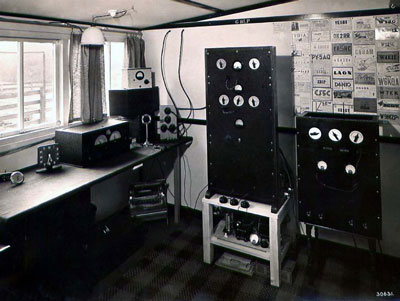 volunteered, for
service as a
Voluntary Interceptor
and would spend hour after hour listening into all the
radio traffic, identifying those which could not be
recognised as genuine commercial or military
transmissions, recording them and then submitting them by
post on a log sheet which showed date, time, frequency and
details of the transmission.
Here is the interior of his "radio shack" in 1937
(right) in which
all these long hours were to be spent. Just three years
later and for a long time afterwards, whenever the sirens
went, he would
shepherd his wife, two boys and Buller down the
garden to the air-raid shelter. After they were safely
installed it would be into his shack, blacked out but
otherwise unprotected from what was going on overhead, for
the night's vigil. On many other occasions, when the
Luftwaffe was not threatening, it was merely the
abandonment of warm fireside and family company, for duty
always called, over four and a half long years.
volunteered, for
service as a
Voluntary Interceptor
and would spend hour after hour listening into all the
radio traffic, identifying those which could not be
recognised as genuine commercial or military
transmissions, recording them and then submitting them by
post on a log sheet which showed date, time, frequency and
details of the transmission.
Here is the interior of his "radio shack" in 1937
(right) in which
all these long hours were to be spent. Just three years
later and for a long time afterwards, whenever the sirens
went, he would
shepherd his wife, two boys and Buller down the
garden to the air-raid shelter. After they were safely
installed it would be into his shack, blacked out but
otherwise unprotected from what was going on overhead, for
the night's vigil. On many other occasions, when the
Luftwaffe was not threatening, it was merely the
abandonment of warm fireside and family company, for duty
always called, over four and a half long years.
So this was the secret activity
in which Geoff was deeply involved. At regular intervals
he would repair to the Bradmore Post Office to send off
the signals, often to Bletchley Park, no doubt using the
procedure outlined above. Sometimes he would
compare notes with another Wolverhampton Voluntary
Interceptor, David Etchalls.
Precisely when and how Geoff
became involved in this very
secret work is unknown, as is much else. In
particular, did he spend much or any time on the
conventional infantry activities of his Battalion? Was his Home Guard membership little more than a cover? Or, if he
did spend time on HG activities in addition to his radio
monitoring duties, how did he balance the two? How did he
divert the suspicion of neighbours and friends at a time
when every single person was on the lookout for suspicious
activity?
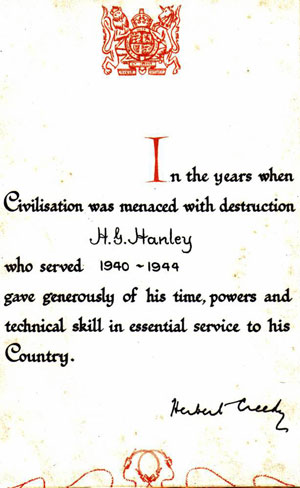 But what is
certain is that Geoff Hanley spent hundreds of hours
wearing his headphones, listening out for and recording,
through a haze of static, the faintest dot-dot-dashes from
across Nazi dominated Europe - messages whose real meaning
he would never know but any one of which might be of the
utmost significance in the pursuit of the war. And he never divulged the
slightest detail. A remarkable record of devoted service,
on top of all the other pressures of the time, and of determination to maintain his duty of
silence for the rest of his life.
But what is
certain is that Geoff Hanley spent hundreds of hours
wearing his headphones, listening out for and recording,
through a haze of static, the faintest dot-dot-dashes from
across Nazi dominated Europe - messages whose real meaning
he would never know but any one of which might be of the
utmost significance in the pursuit of the war. And he never divulged the
slightest detail. A remarkable record of devoted service,
on top of all the other pressures of the time, and of determination to maintain his duty of
silence for the rest of his life.
This service was
recognised after the war by an appropriate certificate of
appreciation signed by Sir
Herbert Creedy, a very distinguished War Office
civil servant who had contiunued to work there throughout
the war, after his official retirement in 1939 from the
post of Permanent Under-Secretary for War.
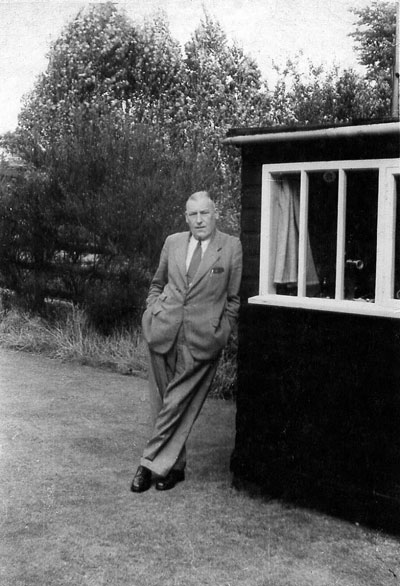
And of course, the wireless
interest survived the war years and continued for long
afterwards, as these final postwar images
(left and below) confirm.
(The image below is a
view from a neighbouring house in Willow Road and shows,
in the left hand half of the image, the two masts and also
part of the radio shack between them in Geoff's garden).
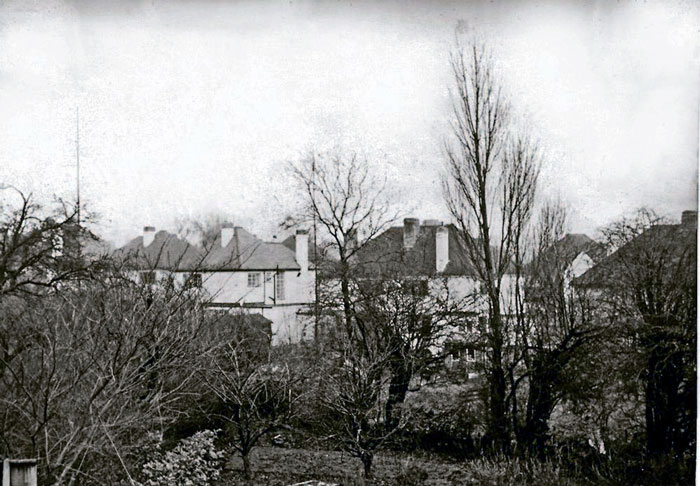
**********
In memory of
Sgt. Geoff Hanley
and all his comrades
in
22nd Staffordshire (Wolverhampton) Battalion,
Home Guard
|
 |
Further information
on this Battalion
Many of the men of the 22nd
Staffordshire (Wolverhampton) Battalion can
be seen in a number of magnified, high definition
photographs
on this
page of the website. Most of the officers are
identified and they include men of whom mention is made on
this page.
A further page exists containing the story of
an officer in the Battalion,
2/Lt. John
Penrose.
For other
references to this and neighbouring Battalions, please use
the Mems-Staffs
link
below or the site
SEARCH
function.
Acknowledgement
Grateful
acknowledgement is made to Robert Hanley for providing this information about his father and generously permitting its publication;
and to Helen Steatham and Anne Almond
(Bantock House Museum) and the
Wolverhampton
Express & Star newspaper for their work in researching
and making public Sgt. Hanley's secret wartime
acitivities.